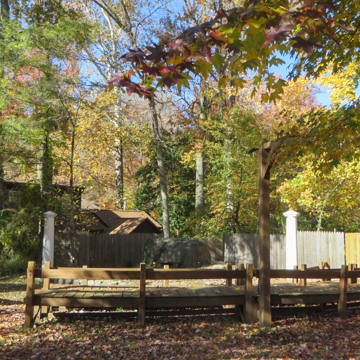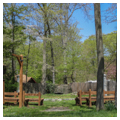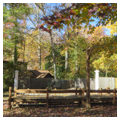You are here
Frank Stephens Memorial Theater (Open-Air or Field Theatre)
The first area of Arden to be settled was around Village Green, a field in an angle of the woods. A huge boulder suggested a backdrop for an outdoor theater, fronted by a turf stage and originally flanked by two wooden Ionic columns. Patrons sat on grass seats up front or wooden benches; the stage was lit with Japanese lanterns and, later, carbide lights and kerosene footlamps. Plays were a cherished community-building activity, starting with Merchant of Venice in 1906 with Stephens as Shylock and William Price as Antonio. In 1909, plays were performed in Esperanto, another of Stephens's passions. During the fall festival of 1912, the Stephens Cottage next door (BR8) was used as a backdrop for Robin Hood, illuminated by automobile headlights. In early performances, actors robed at the Craft Shop (BR11), then marched across the Green by candlelight. The boulder provided a balcony for Juliet and a cliff for King Lear. Renamed for Stephens in 1961—his ashes lie buried beside the rock—the theater today hosts concerts and weddings, and Shakespeare is still performed at least once a year.
Writing Credits
If SAH Archipedia has been useful to you, please consider supporting it.
SAH Archipedia tells the story of the United States through its buildings, landscapes, and cities. This freely available resource empowers the public with authoritative knowledge that deepens their understanding and appreciation of the built environment. But the Society of Architectural Historians, which created SAH Archipedia with University of Virginia Press, needs your support to maintain the high-caliber research, writing, photography, cartography, editing, design, and programming that make SAH Archipedia a trusted online resource available to all who value the history of place, heritage tourism, and learning.


















